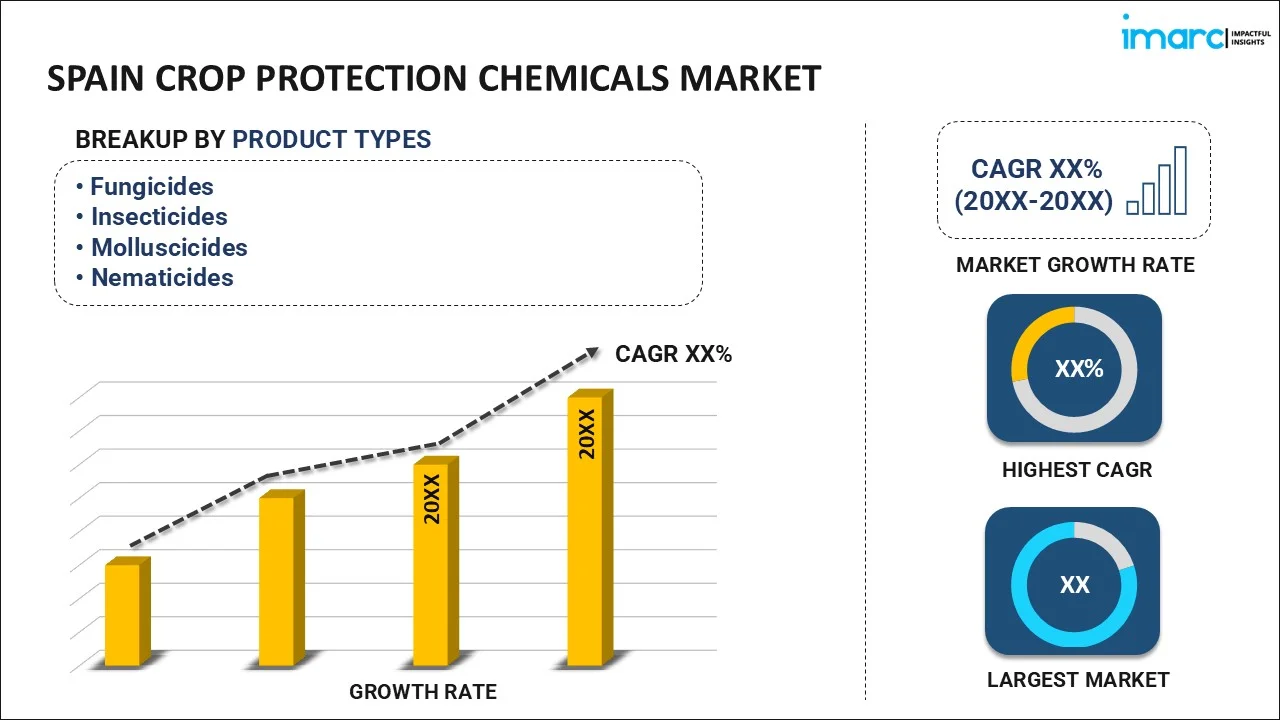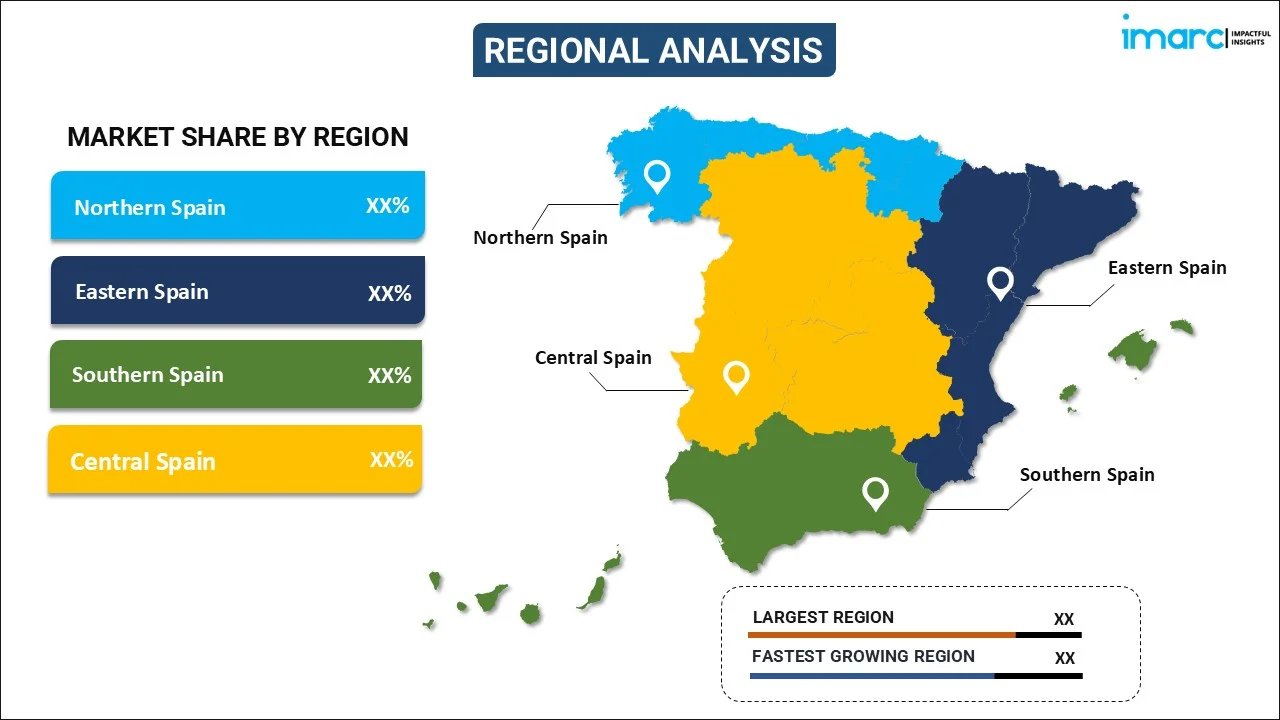
Spain Crop Protection Chemicals Market Size, Share, Trends and Forecast by Product Type, Application, Crop Type, and Region, 2025-2033
Spain Crop Protection Chemicals Market Overview:
The Spain crop protection chemicals market size reached USD 827.3 Million in 2024. Looking forward, IMARC Group expects the market to reach USD 1,236.4 Million by 2033, exhibiting a growth rate (CAGR) of 4.10% during 2025-2033. The Spain crop protection chemicals market is shifting toward sustainable solutions due to stringent EU regulations and rising organic farming. Moreover, demand for biological fungicides and integrated pest management is increasing, driven by environmental concerns, technological advancements, and industry efforts to reduce synthetic pesticide dependency.
|
Report Attribute
|
Key Statistics
|
|---|---|
|
Base Year
|
2024 |
|
Forecast Years
|
2025-2033
|
|
Historical Years
|
2019-2024
|
| Market Size in 2024 | USD 827.3 Million |
| Market Forecast in 2033 | USD 1,236.4 Million |
| Market Growth Rate (2025-2033) | 4.10% |
Spain Crop Protection Chemicals Market Trends:
Rising Demand for Biological Fungicides
In Spain, the crop protection chemicals sector is witnessing a strong shift toward biological solutions, particularly in fungicide applications. Moreover, farmers are increasingly using biological fungicides due to strict EU rules restricting the use of conventional pesticides and growing worries about the environmental impact of synthetic chemicals. As customer demand for organic and pesticide-free products rises, farming methods are changing to include sustainable options. While lowering chemical residues in food production, biological fungicides provide efficient disease control. For instance, in February 2024, Bee Vectoring Technologies and Agrobío SL initiated trials in Spain under the EU-funded ADOPT-IPM project. The trials focus on evaluating BVT's bio-fungicide (CR-7) against Botrytis in greenhouse tomatoes. By providing an alternative to chemical fungicides, this development highlights the increasing role of biological crop protection methods in Spanish agriculture. The adoption of such technologies improves integrated pest management (IPM) techniques and aligns with the environmental aims of the European Union. Furthermore, as regulatory constraints tighten and environmental sustainability becomes more important, the demand will be sustained by advancements in bio-based solutions, which will help the larger shift to sustainable crop protection techniques while preserving important crops' disease resistance and productivity.
Expansion of Integrated Pest Management (IPM)
Spain's crop protection industry is experiencing a rapid shift toward integrated pest management (IPM) due to stricter pesticide regulations and increasing environmental awareness. IPM strategies promote a balanced approach by combining biological, cultural, and chemical control methods to minimize pest resistance and environmental damage. Farmers are adopting IPM solutions to comply with government directives that encourage sustainable agricultural practices while maintaining crop productivity. The rise of precision agriculture and advancements in digital pest monitoring tools are further enabling effective IPM implementation. In July 2023, BASF and Vivagro collaborated to distribute Essen'ciel, a biological fungicide and insecticide based on sweet orange essential oil, in Spain and Italy. This partnership enhances BASF's BioSolutions portfolio and supports the transition toward organic crop protection. The introduction of plant-based pest control solutions reinforces Spain's efforts to reduce dependence on synthetic pesticides and encourages widespread IPM adoption among growers. Spain's agricultural sector is incorporating biological controls and alternative pest management approaches as a result of ongoing investments in research and innovation. Besides this, it is anticipated that industry-led initiatives and government backing will hasten the adoption of IPM, ensuring long-term sustainability and better management of pest resistance across a range of crop categories.
Spain Crop Protection Chemicals Market Segmentation:
IMARC Group provides an analysis of the key trends in each segment of the market, along with forecasts at the region/country level for 2025-2033. Our report has categorized the market based on product type, application, and crop type.
Product Type Insights:

- Fungicides
- Insecticides
- Molluscicides
- Nematicides
The report has provided a detailed breakup and analysis of the market based on the product type. This includes fungicides, insecticides, molluscicides, and nematicides.
Application Insights:
- Chemigation
- Foliar
- Fumigation
- Seed Treatment
- Soil Treatment
A detailed breakup and analysis of the market based on the application have also been provided in the report. This includes chemigation, foliar, fumigation, seed treatment, and soil treatment.
Crop Type Insights:
- Grains and Cereals
- Pulses and Oilseeds
- Fruits and Vegetables
- Commercial Crops
- Turf and Ornamental Crops
A detailed breakup and analysis of the market based on the crop type have also been provided in the report. This includes grains and cereals, pulses and oilseeds, fruits and vegetables, commercial crops, and turf and ornamental crops.
Regional Insights:

- Northern Spain
- Eastern Spain
- Southern Spain
- Central Spain
The report has also provided a comprehensive analysis of all the major regional markets, which include Northern Spain, Eastern Spain, Southern Spain, and Central Spain.
Competitive Landscape:
The market research report has also provided a comprehensive analysis of the competitive landscape. Competitive analysis such as market structure, key player positioning, top winning strategies, competitive dashboard, and company evaluation quadrant has been covered in the report. Also, detailed profiles of all major companies have been provided.
Spain Crop Protection Chemicals Market News:
- February 2025: Sumitomo Chemical fully acquired Philagro and announced plans to acquire Kenogard, strengthening its crop protection business in Europe. The company is expanding its biorational and chemical solutions, enhancing sustainable agriculture, and aiming to double regional sales by 2030 through M&A and integration strategies.
- January 2024: Syngenta Vegetable Seeds inaugurated a modernized breeding innovation center in El Ejido, Spain, enhancing R&D for disease-resistant vegetable seeds. The USD 3 Million investment integrates advanced pathology labs and digital tools, promoting reduced dependence on chemical crop protection and accelerating the shift toward integrated pest management (IPM) solutions.
Spain Crop Protection Chemicals Market Report Coverage:
| Report Features | Details |
|---|---|
| Base Year of the Analysis | 2024 |
| Historical Period | 2019-2024 |
| Forecast Period | 2025-2033 |
| Units | Billion USD |
| Scope of the Report |
Exploration of Historical Trends and Market Outlook, Industry Catalysts and Challenges, Segment-Wise Historical and Future Market Assessment:
|
| Product Types Covered | Fungicides, Insecticides, Molluscicides, Nematicides |
| Applications Covered | Chemigation, Foliar, Fumigation, Seed Treatment, Soil Treatment |
| Crop Types Covered | Grains and Cereals, Pulses and Oilseeds, Fruits and Vegetables, Commercial Crops, Turf and Ornamental Crops |
| Regions Covered | Northern Spain, Eastern Spain, Southern Spain, Central Spain |
| Customization Scope | 10% Free Customization |
| Post-Sale Analyst Support | 10-12 Weeks |
| Delivery Format | PDF and Excel through Email (We can also provide the editable version of the report in PPT/Word format on special request) |
Key Questions Answered in This Report:
- How has the Spain crop protection chemicals market performed so far and how will it perform in the coming years?
- What is the breakup of the Spain crop protection chemicals market on the basis of product type?
- What is the breakup of the Spain crop protection chemicals market on the basis of application?
- What is the breakup of the Spain crop protection chemicals market on the basis of crop type?
- What are the various stages in the value chain of the Spain crop protection chemicals market?
- What are the key driving factors and challenges in the Spain crop protection chemicals market?
- What is the structure of the Spain crop protection chemicals market and who are the key players?
- What is the degree of competition in the Spain crop protection chemicals market?
Key Benefits for Stakeholders:
- IMARC’s industry report offers a comprehensive quantitative analysis of various market segments, historical and current market trends, market forecasts, and dynamics of the Spain crop protection chemicals market from 2019-2033.
- The research report provides the latest information on the market drivers, challenges, and opportunities in the Spain crop protection chemicals market.
- Porter's five forces analysis assist stakeholders in assessing the impact of new entrants, competitive rivalry, supplier power, buyer power, and the threat of substitution. It helps stakeholders to analyze the level of competition within the Spain crop protection chemicals industry and its attractiveness.
- Competitive landscape allows stakeholders to understand their competitive environment and provides an insight into the current positions of key players in the market.
Need more help?
- Speak to our experienced analysts for insights on the current market scenarios.
- Include additional segments and countries to customize the report as per your requirement.
- Gain an unparalleled competitive advantage in your domain by understanding how to utilize the report and positively impacting your operations and revenue.
- For further assistance, please connect with our analysts.
 Request Customization
Request Customization
 Speak to an Analyst
Speak to an Analyst
 Request Brochure
Request Brochure
 Inquire Before Buying
Inquire Before Buying




.webp)




.webp)












